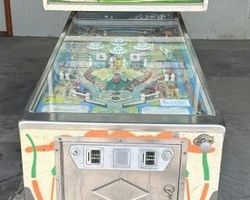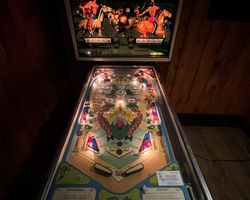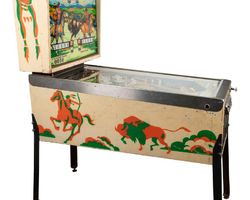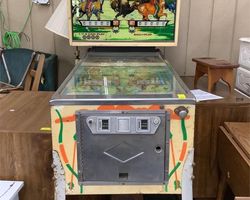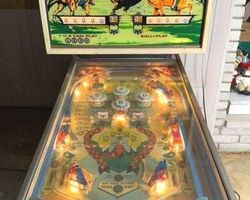Bow and Arrow
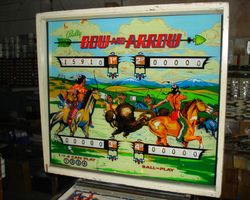
Average Prices: USD $200 to $1,000
Produced: November, 1975
Production Run: 7,630 units
Machine Type: Electro-mechanical
Players: 4
Design by: Greg Kmiec
Art by: Christian Marche
The latter half of the 1970s marked a pivotal transition in pinball, as electro-mechanical (EM) machines began to give way to solid-state technology. Yet, amidst this shift, Bally Manufacturing Corporation continued to deliver compelling EM experiences. One such release was "Bow and Arrow," launched in November 1975. This machine stands as a testament to the enduring appeal of well-crafted EM design, benefiting from the collaborative talents of designer Greg Kmiec and artist Christian Marche. Kmiec, known for his ability to craft engaging playfields, partnered with Marche, whose distinctive artistic vision brought the machine's theme to life. The theme itself, rooted in Americana and the American West with strong Native American influences, was a popular choice for pinball art of the era.
Bally produced 7,630 units of "Bow and Arrow," a significant run for an EM machine in its final years of dominance, indicating both its market appeal and Bally's confidence in its design. This production volume ensured "Bow and Arrow" found its way into arcades and homes across the country, becoming a familiar presence for players. Beyond its commercial success, "Bow and Arrow" holds a unique place in pinball history due to specific developmental efforts. Notably, Norm Clark, a prominent figure in pinball engineering, utilized several "Bow and Arrow" units as testbeds for early solid-state design concepts. This experimentation underlines the machine's role not just as a player experience, but also as a stepping stone in the industry's technological evolution, bridging the gap between two distinct eras of pinball manufacturing.
Signature Features and Design
"Bow and Arrow" distinguishes itself with a combination of visual artistry and mechanical innovation that defines its character. Christian Marche’s artwork is a prominent highlight, extending across the backglass and playfield. The backglass, in particular, is frequently lauded for its superb composition, vibrant colors, and unique depiction of the American West, capturing a sense of adventure and thematic depth that drew players in. This aesthetic cohesion carries onto the playfield, where the artwork integrates seamlessly with the mechanical elements, contributing to a unified and engaging visual experience.
Mechanically, the machine's most celebrated feature is its pair of spinning targets. Strategically placed, these "double spinners" are central to gameplay, offering a satisfying "ripping" sensation as the ball passes through them. This mechanical action is not merely for show; it is directly tied to the primary scoring mechanic, making them a continuous focus for players. Another notable innovation for its time was the continuous motion of lights. This visual effect, reminiscent of Bally's "Skyrocket" animation, created a dynamic and engaging display as points accumulated, providing immediate and exciting feedback to the player. Furthermore, "Bow and Arrow" incorporates a motorized Flash Bonus system on one of its kick-out holes and a standup target. This mechanism introduces variability to award values, injecting an element of surprise and further encouraging players to aim for these specific targets, enhancing replayability and strategic depth.
Playfield and Mechanics
The "Bow and Arrow" playfield is a carefully crafted arena designed to maximize ball time and scoring opportunities, characteristic of Greg Kmiec's design philosophy. At its foundation are two flippers, providing the primary means of ball control and shot execution. Above these, two slingshots effectively redirect the ball, often sending it into the upper playfield where much of the action unfolds. Central to the upper playfield are four powerful pop bumpers, known for their strong action that can propel the ball with lightning speed, creating chaotic and exciting sequences. These bumpers frequently send the ball careening into the twin spinning targets, a core element of the game.
The playfield features six standup targets, some forming an "ABCD" sequence. While these targets contribute to scoring and can light various features, their position sometimes makes them accidental hits, adding an element of unpredictability. Two kick-out holes are present; one serves as a collection saucer in the upper-left, crucial for bonus collection, while the other (often paired with a standup target) features the motorized Flash Bonus, offering variable point awards. A right ball return gate facilitates continuous play, keeping the action flowing. The overall design emphasizes a fluid game flow, where shots often lead into the pop bumper array and subsequently towards the valuable spinners. The playfield's artwork, consistent with the American West theme, is vivid and detailed, complementing the action, while the lighting scheme effectively highlights critical targets and scoring elements, enhancing player immersion.
Gameplay Dynamics
The core gameplay loop of "Bow and Arrow" revolves around a simple yet compelling objective: accumulating and collecting a substantial bonus. This is primarily achieved by repeatedly striking the two spinning targets. Each pass through these spinners rapidly builds the end-of-ball bonus, creating a tangible sense of progression and reward. The satisfying sound and visual feedback of these "ripping" spinners make this a consistently engaging mechanic. Once a significant bonus has been built, the strategic objective shifts to collecting it. This is done by guiding the ball into the collection saucer located in the upper-left corner of the playfield, a shot that requires precision and timing. Successfully collecting the bonus provides a surge of points, making this moment a highlight of any game.
Beyond the primary bonus system, the machine offers several avenues for scoring and progression. The four powerful pop bumpers, strategically placed, contribute significantly to the game's fast pace. They keep the ball in motion, often directing it into the path of the spinning targets or other scoring elements, generating a high-energy experience. The "continuous light motion," a visual spectacle for its era, also contributes to scoring, providing players with additional points as the lights animate across the playfield. Other targets, such as the six standup targets, contribute to base scoring and can light specific features. A center target, when hit, awards extra balls, providing a lifeline and extending gameplay. While the scoring system allows for a maximum displayed score of 199,990 points per player, the ability to repeatedly build and collect the bonus without it resetting after collection often allows for very high scores, providing a distinct challenge for players aiming to master its scoring potential.
Reception and Legacy
"Bow and Arrow" is widely regarded within the pinball community as a robust and enjoyable electro-mechanical machine, often described as a "keeper" by collectors. Its reception has been largely positive, with enthusiasts praising its straightforward yet engaging gameplay. The dual spinning targets are consistently highlighted as the machine's greatest strength; the satisfying sensation of "ripping" these spinners to build bonus points is a central reason for its enduring appeal. Players appreciate the rewarding nature of the bonus collection mechanic via the upper-left saucer, which provides a clear objective and a significant point payout. Christian Marche's artwork, particularly the backglass, receives frequent accolades for its beauty, vibrant colors, and strong thematic presentation, contributing significantly to the machine's aesthetic charm. For an EM machine of its era, "Bow and Arrow" is noted for its fast pace and powerful pop bumper action, creating a dynamic playfield experience that remains engaging.
Despite its many strengths, some experienced players find "Bow and Arrow" to be less challenging than other titles, particularly when playing on a five-ball setting. The ability to collect the bonus repeatedly without it resetting has been noted by some as potentially making the game "too easy" to achieve very high scores, diminishing some of the competitive tension. Additionally, the ABCD targets, while part of the playfield layout, are sometimes considered more a matter of chance than skillful aiming. The outlanes, too, can be particularly unforgiving.
Despite these minor criticisms, "Bow and Arrow" maintains a strong reputation as a classic EM from its period. It is considered one of the last significant electro-mechanical games released before the widespread adoption of solid-state technology, making it a valuable representation of the culmination of EM design. Its influence can be seen in how it effectively demonstrated the power of a simple, yet deeply satisfying, core mechanic—the spinners and bonus collection—driving replayability and player engagement. Its enduring appeal to collectors of EM machines underscores its place as a well-designed, fun, and historically relevant title in the evolution of pinball.
Sponsored Links
 Ebay Listings
Ebay Listings
 Auction Results
Auction Results
| Cost | Location | Date |
|---|---|---|
| USD $350 |  New York, United States New York, United States |
10 October, 2025 |
| USD $200 |  New York, United States New York, United States |
31 May, 2025 |
| USD $280 |  Illinois, United States Illinois, United States |
05 May, 2025 |
| EUR €1,900 |  Schlewig-Holstein, Germany Schlewig-Holstein, Germany |
29 October, 2024 |
| USD $345 |  Michigan, United States Michigan, United States |
09 October, 2024 |
| USD $700 |  Texas, United States Texas, United States |
07 May, 2023 |
| USD $500 |  South Carolina, United States South Carolina, United States |
10 April, 2023 |
| USD $900 |  Texas, United States Texas, United States |
07 April, 2023 |
| EUR €1,900 |  Niedersachsen, Germany Niedersachsen, Germany |
15 February, 2023 |
| GBP £600 |  United Kingdom United Kingdom |
24 January, 2023 |


Private Policy · Search Website · Contact Us
As an eBay Partner, we may earn a commission from qualifying purchases made through links on this site, at no additional cost to you.
All trademarks and copyrighted materials remain property of their respective owners. All other content copyright 2007 - 2025 Pinpedia.

